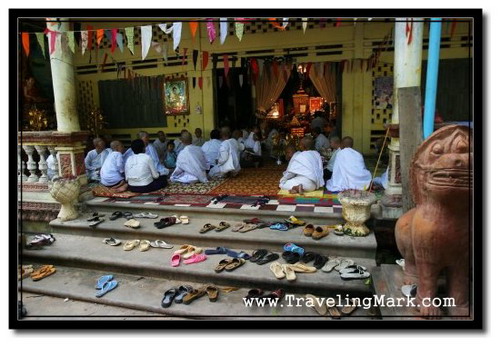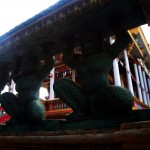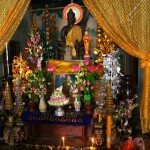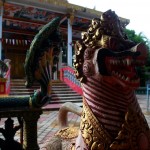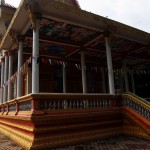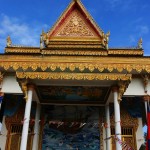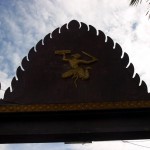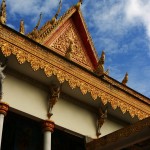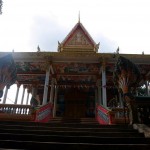After much hustle and bustle, with nothing else getting in the way, I was finally laying my first steps across the sandstone causeway that bridges the moat surrounding Angkor Wat. Vastly unhindered, I wiped the sweat off my face into a t-shirt and headed straight against the sun. The wait was over, I am here, exploring Angkor Wat.

Based on Hindu mythology, Angkor Wat represents the center of the universe with five peaks of Mount Maru in its center. Being world’s largest religious monument, the name of Angkor Wat justifies its meaning in Khmer language – city which became a temple. When you go exploring Angkor Wat, you will find yourself within the walls of what was once a magnificent city. Today, Angkor Wat remains an architectural masterpiece of Khmer construction graced by almost 2,000 carvings of Apsaras and 600 meters of narrative bas reliefs.
The sandstone bridge across the moat is said to have replaced the wooden bridge that once existed to connect the outside world with the temple but has decayed overtime. The bridge as it is right now doesn’t have any railings or other barrier to protect people from falling into the moat. The balustrade is a body of a seven-headed serpent but only exists at expanded areas of the bridge. Yet because this is Cambodia and not North America, there were no signs warning people of not coming too close to the edge or risking the danger of falling into the moat. However there was a sign protecting the balustrade from damage that sitting on it could cause. Good call.
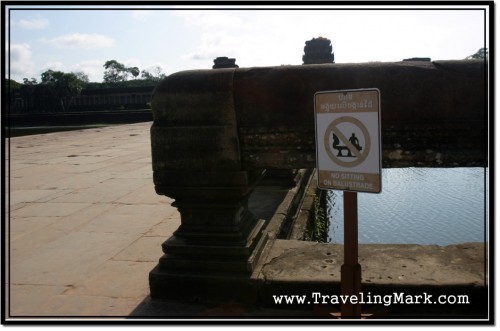
Several young boys spent the morning jumping off the bridge and into the moat to cool their bodies off and protect themselves from scorching heat. Others sat on the edge with hand-made fishing rods looking to catch the fish to eat for supper. Even though Angkor Wat is a popular tourist destination, the life for villagers doesn’t stop so they continue doing what they used to prior to the temples of Angkor becoming as popular as they are now. The presence of thousands of tourists doesn’t seem to bother them at all (or maybe it serves as a way to show off).
Few steps lead to the west gopura – an entrance pavilion that serves as a main gateway to the hallways and passages within the exterior wall. Bunch of locals were sitting at the doorway steps making me the only who could not wait to get inside to hide from the sun that was frying me alive.
To the left and to the right of this central gopura there are additional entrances with doorways large enough to allow an elephant through. This gave them the name of “Elephant Gates”. It is quite likely that when Angkor Wat was constructed, there were bridges across the moat each leading to either of the Elephant Gates.

To the right of main gopura there is small shrine still within the outer enclosure which contains a statue of Vishnu. This statue with eight arms is believed to have once been located in Angkor Wat’s central sanctuary (while the temple was still dedicated to Hinduism).
As I continued exploring the insides of the exterior wall, I noticed that there were many, randomly placed statues of both Buddha and Vishnu (mostly Buddha) there. You could tell one was nearby by smelling the essence of burning sticks. There would usually be some locals knelt before the statue, praying to the deity it represents holding their own incense stick firmly clasped between their palms. On top of people praying though, there would also be scam artists, often involving old women with shaved heads (female version of a monk) who would hand you a burning stick and prompt you to put it with all others in a holder at the statue’s feet for good luck and fortune, but the catch is that they would insist on a donation which as they claim would go to the monks and to upkeep the temple. This is obviously a scam. None of the money will be used any way other than personally by the person who gets it from you. These people hang around the spots where tourists go and abuse the holy place and the divinity portrayed for their own enrichment. They work with the moment of surprise, appearing next to you out of nowhere, handing you the incense stick. Unaware what to do, it is a natural instinct of a foreigner to take what is offered to the, so as not to offend anyone and show respect for a deity that may be anticipating this action. Unfortunately, once you take hold of an incense stick, it will be difficult to talk your way out of handing the money over. If anything is handed to you, don’t ever take it or it instantly means that you have to pay for it.
Even though passages inside the walls provide shelter from the devastating rays of Cambodian sun, they won’t offer many opportunities to cool off. It’s as hot or hotter within those stone walls as it is outside on direct sun. The sun roasts the stones every day and that heat radiates back keeping the corridors at the boiling point. You basically have nowhere to hide from noncompromising heat and unless you keep well hydrated, Angkor Wat is gonna burn you out sooner than you’d care to admit.
There is no electricity in any of the temples hence no chance of stepping in an air-conditioned room or at least as little as a fan to wash the sweat off your brow. Exploring Angkor Wat is an extremely hot and sweaty effort. I’ve met several people who underestimated Cambodian heat, purchased three day passes to Angkor but only used their first day. They could not handle any more of that heat and let the rest of their entrance pass go to waste.
Since there is no electricity within Angkor Wat, the only source of light is through the windows which are evenly distributed throughout the walls. Windows are nicely decorated with lathe-turned balusters keeping the awe ongoing no matter which part of Angkor Wat you are exploring at any given moment.
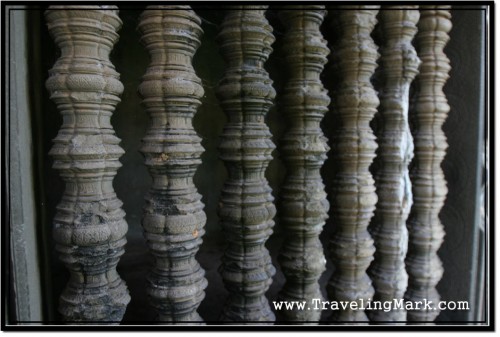
As the name of the temple suggests, Angkor Wat was once a city. The scale of the city became evident after I exited the passages inside the exterior wall and stepped back down onto a causeway that follows through until it reaches the cruciform terrace staircase of the central temple 350 meters further. Only houses of Gods were built of stone, human dwellings were built of wood and have long since been claimed by the decay of time. Vast, open areas on both sides of the causeway once housed dwellings for people who resided in Angkor Wat. Even king Suryavarman II’s castle was made of wood and is believed to have been located just north of the central temple. People did not live within the structures we see at Angkor today. Human dwellings are all gone. What is left are mountain-temples built for the gods, such as Vishnu to whom Angkor Wat was dedicated.
Causeway is decorated on both sides with balustrades in the form of seven-headed serpents locally known as “nagas”. There are seven nagas on each side of the causeway. After about 50 meters, each of the nagas turns and that’s where an access point to the original city from the causeway is created. You can take the steps down to walk on the grass or to get to the libraries which are each on one side of the causeway further ahead.

Since it was an early morning and the temple ahead of me was not very photogenic due to strong backlight created by the rising sun, turning around to take pictures of the gapura behind me was awesome. There are some apsara carvings on the insides of the exterior wall which look great in the morning light and the whole wall also makes for some decent photos on its own.
Libraries are stand alone buildings with doorways on each cardinal point and are believed to have been shrines, rather than manuscript repositories. They are not that big on the inside, but the space gains on volume thanks to their height. They are otherwise empty and don’t attract that many people. Just as the rest of Angkor Wat, you will find temporary refuge from devastating sun rays, but no feeling of cooler air whatsoever. It’s as hot or hotter within the libraries as ancient stones bombarded by unceasing sunrays radiate heat of their own turning each of the libraries into a sauna.
Further ahead of the libraries are two ponds. The one on the left is where best pictures of Angkor Wat can be taken from. You can get the shape of the temple reflected by the waters of the pond and that simply can not be beat. There is no better spot to take pictures of Angkor Wat anywhere within the enclosure. Perhaps from the air, if you took a helicopter tour, then you could match the awesomeness of the pond picture, but unless you shell out for an option to get aerial shots, this is your best spot. Again though, it’s gonna look like crap in the morning because of strong backlight, however you do have to come back in the afternoon anyway so when you do, that’s where you’re gonna go to get your best shots of Angkor Wat.
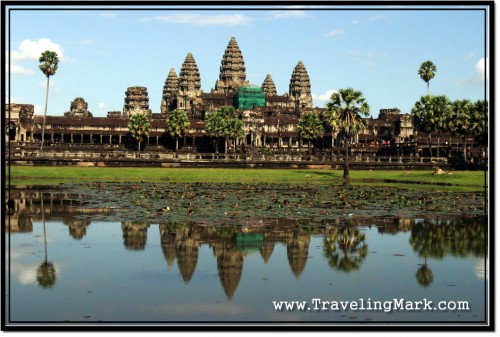
It is said that the ponds have not been the part of the original design of Angkor Wat. The space they occupy was originally dedicated to the dwellings of city’s residents but after the city was abandoned and houses fell apart (16th century?), ponds were created in their place. The cruciform terrace that’s at the top of the staircase starting at the end of the causeway bears architectural elements that differ from the rest of the city making scholars believe that it was also added later.
Cruciform terrace contains a gopura that leads inside the central temple. Since the terrace is elevated, turning back and facing the sun illuminated area which was once a powerful and prosperous Khmer city offers yet better impression of its scale. Hidden under the line of trees along the northern exterior wall are stalls with beverages, snacks and souvenirs. You need to allow about (understand “at least”) two hours to properly explore Angkor Wat and take my word for it – 15 minutes under Cambodian sun is more than enough to handle at one time. By the time you have gotten to the cruciform terrace, it’s actually time to walk back down to hide under the trees and recharge bodily fluids with cold water or, better yet – fresh coconut. You’ll need more energy for the next step – exploring the Angkor Wat central temple.


